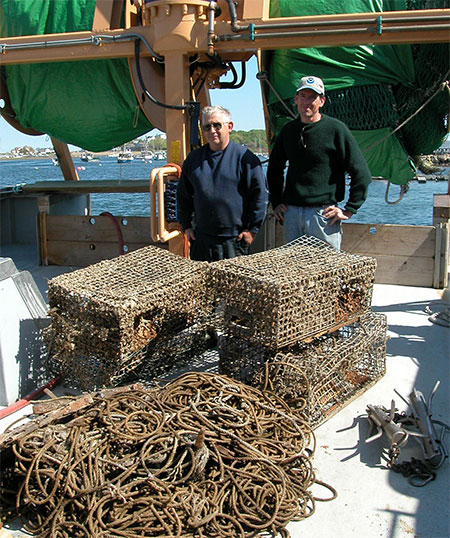Marine Debris
Stellwagen Bank

Why is it a concern?
Levels of debris in both the ocean and at the land-sea interface are of growing concern. Marine debris poses a growing threat to marine life and biological diversity in the Stellwagen Bank sanctuary and various types of debris are known to have adverse effects on marine species. Ingestion and entanglement are two of the largest problems associated with marine debris, which may cause injury and death to selected marine wildlife, including some endangered and protected species found in the Stellwagen Bank sanctuary.
Marine animals within the sanctuary can also be harmed by ingesting marine debris, often mistaking it for food resulting in starvation or poisoning. Plastics in the marine environment never fully degrade and recent studies show plastic is consumed by organisms at all levels of the marine food web. Entanglement in marine debris is another serious problem, and it has been linked to measurable population declines for a variety of marine mammals. Lost fishing gear can create long-term entrapment mechanisms that continuously kill mobile fauna for many years. Net materials are constructed to be strong and resilient, thus preventing escape of entangled wildlife and persisting in the environment for decades. Lost cage traps continue to catch prey on a continuing cycle as predators enter the traps to feed on dead and dying entrapped organisms. Nets and traps can physically scrape organisms off of hard reef habitat or sweep immobile invertebrates from sandy areas.Marine debris is a worldwide problem due to the many potential sources of debris, longevity of debris (especially plastics) in the marine environment, and continuing impacts caused by debris even as they degrade to smaller pieces.
Overview of Research
| Project Name | PI and contacts | Links |
|---|---|---|
Removal of ghost gear from SBNMS shipwreck |
SBNMS |
|
Stellwagen Sweep |
Stellwagen Alive! |
Science Needs and Questions
- What are the sources, types and accumulation rates of marine debris within the SBNMS?
- How can we reduce the sources of debris which ends up in the SBNMS?
- What are the impacts to resources (i.e. seafloor habitats or archaeological sites) of removal activities?
- What tools are available to detect marine debris before it enters the SBNMS?
- Should certain critical habitats for endangered or threatened species be prioritized for marine debris removal efforts?
- What is the spatial extent of marine debris in the SBNMS?
- Are certain areas more or less susceptible to marine debris accumulation and/or impacts?
- Are certain types of debris more likely to contain contaminants and can those be targeted for removal efforts?
Education and Outreach Material
Video that takes a look at the marine debris problem and the work undertaken to restore Stellwagen Bank NMS.
NOAA Marine Debris Program Education Materials
References
Gittings, S.R., M. Tartt, and K. Broughton. 2013. National Marine Sanctuary System Condition Report 2013. U.S. Department of Commerce, National Oceanic and Atmospheric Administration, Office of National Marine Sanctuaries, Silver Spring, MD. 33 pp.
U.S. Department of Commerce. National Oceanic and Atmospheric Administration. Office of National Marine Sanctuaries. 2010. Stellwagen Bank National Marine Sanctuary Final Management Plan and Environmental Assessment. Silver Spring,
NMSP (National Marine Sanctuary Program). 2006. Gerry E. Studds Stellwagen Bank National Marine Sanctuary Condition Report 2006. U.S. Department of Commerce, National Oceanic and Atmospheric Administration, National Marine Sanctuary Program, Silver Spring, MD. 39 pp.
NOAA (National Oceanic and Atmospheric Administration). 2008. Marine Debris Emergency Response Planning in the North-Central Gulf of Mexico Interim Draft Report. 44pp.
U.S. Dept. of Commerce and U. S. Navy. 1999. Turning to the Sea: America’s Ocean Future. 56 pp.

